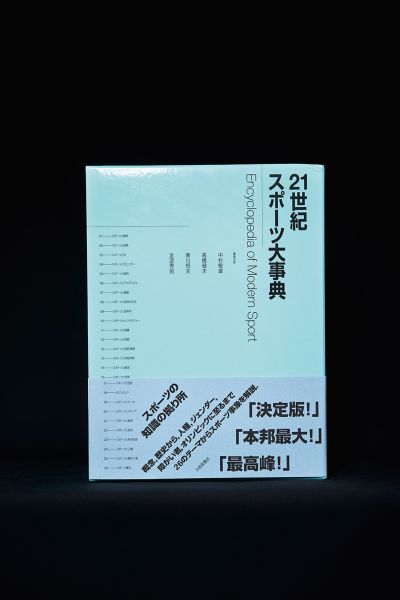Toshio Nakamura, Takeo Takahashi, Tsuneo Sougawa, Hidenori Tomozoe
Encyclopedia of Modern Sport
- Kategorie
- Honorary Appreciation
Begründung der Jury
★
Japan
★
Encyclopedias are attractive because the condensed knowledge inside can be grasped with both hands. They also put fear into people, though— the fear of paper overladen with text, the fear of heavy books, the fear of a thousand pages.
The design of this Japanese reference book dispenses with the sense of heaviness, however. An attractive lightness emanates: the water blue jacket has been given rational yet intuitive typography with fine fonts. The white cover with unusually thin board considering the substantial innerbook can hardly appear lighter, and the greenish-blue endpapers at the front and back can hardly seem more airy. The particularly finely woven headband and both ribbon bookmarks match the colour tone beautifully. Even from the outside, visible on the fore-edge, it is evident that the whole work is structured into manageable portions—with a finely structured arrangement using collating marks, and sorted in horizontal and vertical lines: the ends of the lines on the right-hand side and the separating pages for each segment. Inside the book, we find beautiful, smooth, yellowish-white thin paper with three-column type area and generous spacing between the columns. Black/white photos and reduced-graphic diagrams and sketches have been used sparingly. The entries are structured with fine lines and numbered circles; even the mostly image-free double pages are able to support the light mood of the cover.
This has been achieved by the book design: giving dynamic buoyancy not only to this majestic magnitude for functional reasons, but also to the topic of sport itself.
★
Enzyklopädien sind attraktiv, weil in ihnen komprimiertes Wissen mit beiden Händen zu greifen ist. Sie machen aber auch Angst – Angst vor Bleiwüste, Angst vor einem schweren Buch, Angst vor tausend Seiten.
Doch diesem japanischen Nachschlagewerk nimmt seine Gestaltung die Schwere. Attraktive Leichtigkeit stellt sich ein: Der wasserblaue Umschlag wurde mit feinen Schrifttypen rational und intuitiv zugleich typografiert. Der weiße Einband mit für den beachtlichen Buchblock ungewöhnlich dünnen Deckelpappen kann kaum leichter, Vor- und Nachsatz in blassem Grünlich-Blau kaum luftiger wirken. Das besonders fein gewebte Kapitalband und beide Zeichenbänder passen sehr schön in den Farbklang. Schon außen am Vorderschnitt sichtbar ist das Ganze in handliche Portionen strukturiert – durch die feingliedrige Einteilung mit Flattermarken, einsortiert in horizontale und vertikale Linien, nämlich den Anschnitten der rechtsseitigen Linienleiste und der Flächen der Abschnittstrennseiten.
Das Innere ist auf schönem glattem, gelblichweißem Dünndruckpapier in dreispaltigem Satzspiegel mit deutlichem Spaltenabstand konzipiert. Schwarzweißfotos und grafisch reduzierte Diagramme und Schaubilder wurden sparsam eingesetzt. Die Einträge sind mit feinen Linien und Kreisnummerierung gegliedert; selbst die meistens bildlosen Doppelseiten können die leichte Anmutung der Einbandes bestätigen.
Das ist die Leistung der Buchgestaltung: nicht nur dem stattlichen Umfang aus funktionalen Gründen, sondern auch dem sportlichen Thema überhaupt eine dynamische Federung zu geben.

